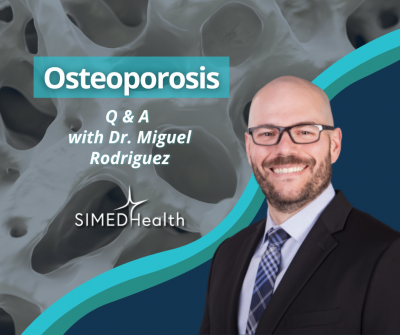
We had questions about osteoporosis and SIMEDHealth Rheumatologist Dr. Miguel Rodriguez had answers!
Dr. Rodriguez sees patients at our Gainesville and Ocala locations; to schedule an appointment, visit https://bit.ly/3t2VJhd .
1. What is osteoporosis?
Osteoporosis is a common bone disease that leads to an increased risk of fracture. Throughout our lives, our bones are constantly being broken down and built up again. Osteoporosis occurs when too much bone is lost and/or too little is made. This causes bones to become brittle and easier to break. In more severe osteoporosis, a minor trip, bump or even a sneeze may be all it takes to break a bone.
2. What are the symptoms of osteoporosis?
Most people with osteoporosis do not know they have the disease until they break a bone which is why osteoporosis is often called a “silent” disease. Once a bone fractures, it can be very painful and may take a very long time to heal. Some symptoms can become more noticeable with worsening disease and may include:
- A gradual loss in height because of compressed vertebrae
- Stooped posture or “Dowager’s hump”
- Persistent back pain from collapsed or fractured vertebrae or other bone pain
- More frequent fractures
3. What are the risk factors for osteoporosis?
Your risk of osteoporosis depends on:
- Your age – bone density declines at a faster rate after the age of 50
- Your diet – a regular intake of calcium and other minerals helps maintain bone health
- How much you exercise and what type of exercise you do - weight-bearing exercises increase bone density
- Sex hormone levels – women after menopause and men with low testosterone are at higher risk
- Sun exposure – sun is needed in small amounts for our skin to make vitamin D
- What other medical conditions you have – people with celiac disease, Crohn’s disease, or rheumatoid arthritis have a higher risk of osteoporosis
- What medicines you take – corticosteroids, antiandrogens, and aromatase inhibitors increase risk
- If you are deficient in any vitamins and minerals such as vitamin D or calcium
- How much you smoke or drink – smoking or a high alcohol intake increases risk
- How much you weigh – people who are underweight generally have lower bone densities
- If you have had any previous fractures
4. How is osteoporosis diagnosed?
Doctors usually diagnose osteoporosis during routine screening for the disease. The U.S. Preventive Services Task Force recommends screening for:
- Women over age 65
- Women of any age who have factors that increase the chance of developing osteoporosis
Your doctor may order a test that measures your bone mineral density (BMD) in a specific area of your bone. The most common test for measuring bone mineral density is dual-energy x-ray absorptiometry (DXA). It is a quick, painless, and noninvasive test. DXA uses low levels of x-rays as it passes a scanner over your body while you lie on a cushioned table. The test measures the BMD of your skeleton and at various sites that are prone to fracture, such as the hip and spine. Bone density measurement by DXA at the hip and spine is generally considered the most reliable way to diagnose osteoporosis and predict fracture risk.
A person can also be diagnosed with osteoporosis if they have a fragility fracture. Fragility fractures occur as a result of “low energy trauma”, often from a fall from standing height or less.
5. What medications are available to treat osteoporosis?
There are a number of different medicines used to treat osteoporosis. Some work by decreasing how fast bone is broken down, others increase the rate at which bone is built back up. Some can only be used in postmenopausal women.
Common medicines prescribed for osteoporosis include:
- Bisphosphonates such as Actonel, Atelvia, Boniva, Binosto, Fosamax, Reclast, and Zometa
- Hormone therapies, that replace missing hormones or mimic the actions of hormones, such as Calcitonin, Duavee, Evista, Femhrt, Forteo, Premarin, or Tymlos
- Prolia – directly targets cells breaking down bone
6. Can osteoporosis be reversed?
Yes! Several treatments have been shown to improve bone density which slows or reverses the progression of osteoporosis, reducing the risk of fracture. However, osteoporosis cannot be cured indefinitely. It requires ongoing actions to maintain your bone density. It’s never too late to treat your osteoporosis. Don’t wait for a fracture to take action.